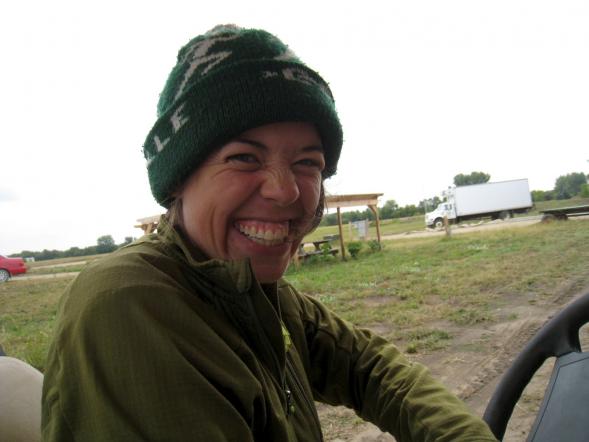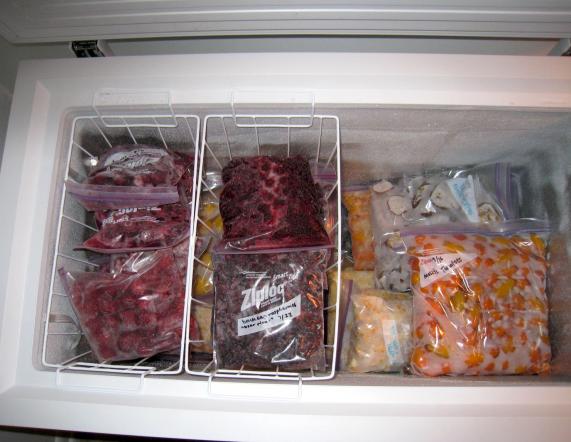For the last week, I’ve awoken with cold feet. Every morning, after quickly shuffling to the kitchen to start a pot of coffee, I’ve shivered quietly about my apartment attempting to locate a pair of clean socks. Though my wool sweaters still sleep soundly in the garage, I know that fall lurks just around the corner, and I’ve begun to prepare myself for the end of summer that autumn always brings.
Fall rolls in slowly, slipping in through cracks in our soil, plunging down with the roots of our lush cover crops, resting with the soft particles of dew clinging to broccoli and cauliflower leaves in the early hours of morning. The cool air pushes us to slow down, step back, and reel it in. Though we haven’t exactly arrived at the closing part of the season, the feeling of rest hangs over us with the morning fog and our eyelids sit poised, ready to close at the completion of our last harvest. For most farmers, this is the magical part of the growing season. Ask them and they will tell you that autumn is their favorite time of year; with waning daylight and cooler temperatures, fall pulls us to the end.
As a farmer, then, I am embarrassed to say that I dread fall. I cringe at the thought of sweaters in the morning, the pull of the wool across my cracked, dry fingertips. I despise the way sweat sneaks up to the surface of my skin during the strenuous labor of picking peppers or pruning poha berries, but refuses to break through, denying my body the self-cooling it so deserves. I cannot stand the wind whipping my exposed cheeks, bringing a sore redness to the tip of my nose and the lobes of my ears. After I lose all feeling in my fingers and toes and fumble kale tie after kale tie, I hunger for the day’s end.
 Molly suited up in her winter hat
Molly suited up in her winter hat
Fall farming slows down. Although the harvests have by no means come to an end and at times continue to break our backs just as they did in the summer, the urgency is somehow lessened: the broccoli heads won’t go past if left in the fields over the weekend; the cucumbers won’t bloat into whales if left on the plant two days too long; the tomatoes no longer blush at the first sign of sun. For spring to feel like agricultural rejuvenation, for the first planting to go smoothly, fall must neatly tuck away the tools, the fields, and the sleeping seeds. Perhaps the surest sign of fall is when we last use, clean, and finally put away an implement for the winter. Just as surely, I look forward to these moments as I persevere through fall’s unique pain.
I often find it difficult to look past the cramping in my hands and the numbness in my fingers to recognize the soothing hush to come. Only sometimes, a few hours during mid-afternoon, after the sun brings life back into my frozen body, the wisps of wind and the calling of fall remind me of the changing pace and fall delicious harvests. These hours allow me to appreciate the beauty of the season, and place my faith in the fading light of day that will so soon bring it all to an end.
---
Often I wonder if I actually hate fall or just fear the end of things. The cooler months force me to ponder what form my life will take without work in the fields, without fresh vegetables in my crisper, without dirt under my fingernails. And when winter finally arrives, when the last kale bunch rolls onto the delivery truck, when the dust begins to settle in the potting shed, I will move on to a job serving coffee and struggle to invest meaning and passion into my work out of the field. This anxiety pushes me to fill my car with extra produce, to preserve our bounty and the vigor with which we plucked it from the field.
I find that farmers take to preservation with much more eccentricity than your avid master preserver. Most of the produce that my girlfriend, Lily, and I freeze, dry, pickle, stew, and roast is free, so why not cart home four bushels of corn and thirty pounds of tomatoes at a time? Why not set aside two or three totes of slightly ugly cucumbers, lovingly called pukes, to pickle over the weekend? Why not buy a new chest freezer to house peppers and cauliflower and broccoli? It will get us through the winter. It will keep us busy after we have wandered away from the fields.
 Only a fraction of the goods we put up last year
Only a fraction of the goods we put up last year
During the last hot week of the summer, I carted home three boxes of tomatoes and refused to eat any fresh, because every single one needed to shed its skin, stew, and then sit in a mason jar for at least three months. After our first round stripping the tomatoes, we couldn’t stop sweating. I sweated through my t-shirt and later in my sleep I sweated through my sheets. We made an emergency trip to ACE Hardware for a new canning pot and two packages of lids; we burned our thighs on the leather seats of Lily’s car and probably bickered on the way home about who would wash the dishes. And we still only got eight quarts from the whole ordeal.
I find that preservation brings out the worst in me and unfortunately the worst in Lily, as well. Canning tends to be uncomfortable. Though the bulk of our harvests come in waves, the first push for salsa and stewed tomatoes and fruit jams arrive when our tolerance for the humidity begins to break and our frustrations with each other and our projects start to fester.
 My new chest freezer
My new chest freezer
This year Lily and I chose to preserve our relationship instead of dilly beans and corn relish and funneled our small savings into a brand new chest freezer. Abandoning the hot water bath for ice not only saves sanity, but time as well. This year there has been little standing time, no constant waiting around for the water to boil, the jars to sanitize, the liquid to once again come to temperature. Instead we throw it all, the cauliflower, corn, kale, cherry tomatoes, blueberries, cherries, green beans, and peppers into our freezer and remember, at least more easily, that we love each other.
My fellow harvest crew leader, Molly, recently told me recently that I suffer from a sickness. Self-diagnosed with tomato obsessive disorder, Molly planted 80 tomato starts of her own, and cans sauce, salsa, and paste at least once a week. I try to keep up the rate of our preservation with Molly’s, to be sure Lily and I will make it through the winter. Though not addicted to tomatoes, I tend to bring home too much produce, packing our refrigerator and our weekend preserving time beyond their carrying capacities. Because not only does the sight of wasted, lost food pull on the bare roots of my heart, my obsession with preservation soothes my longing in the winter, filling the cavern of my stomach and the loss I feel so deeply with the arrival of fall.

Katie Willis is a native of Birmingham, Alabama, where she grew up with NASCAR, twangs and drawls, and lots of fried okra. Her farming career began on an urban farm in Birmingham, where she ate arugula and swiss chard for the first time in her life. Eventually she moved to rural New York to work with chickens, goats, and really strong women. She enjoys a rowdy round of arm wrestling, discussions on all things related to heternormativity, seasonal food preservation, long bike rides, Toni Morrison, and ice-cold beer. Katie recently moved to the Twin Cities with her girlfriend, Lily. They live in Powderhorn and eat lots of butter, maple syrup, and frozen kale. This year marks her seventh season with soil underneath her fingernails and a bounty in her fridge. Her last post for SGT was Farm Journal: Enduring the Heat.

